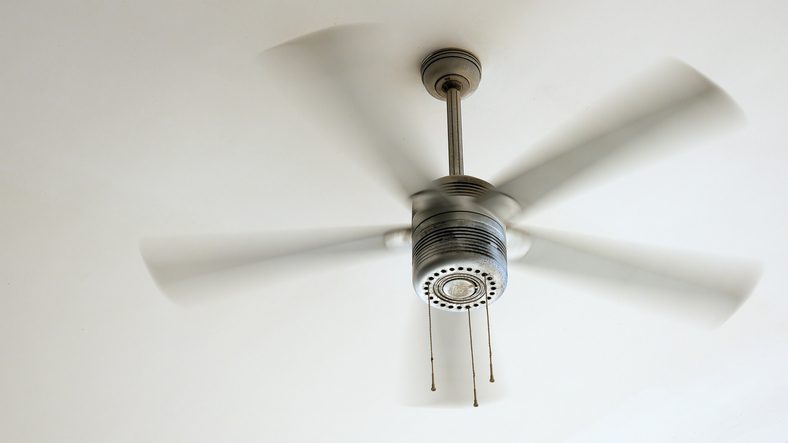Summer’s heat shows no sign of relenting. Running an air conditioner non-stop gets expensive, so it pays to think about low-cost, low-maintenance ways to stay cool.
If you’re considering getting a ceiling fan to help your air conditioner when you’re home, or just keep the air moving when you’re out, here’s what you need to know about ceiling fans and electricity use.
Do Ceiling Fans Use a Lot of Electricity?
No, but it helps to put numbers in context.
Does a ceiling fan use more energy than a phone charger? Sure, but let’s compare it to something relevant. A ceiling fan uses considerably less power than other whole-room cooling appliances, including air conditioners, box fans and tower fans.
Below, we’ll break down the numbers and provide comparisons to other appliances.
How To Calculate Electricity Costs
First, let’s get up to speed on how to calculate electricity use.
Appliances like ceiling fans have a rating in watts (W) that tells you how much power they consume. Wattage will be different on high, medium and low speed, but most fans list the wattage at high speed so we’ll use that for these examples. Ceiling fans have the watts listed on the fan, or in the manual or online description.
Next, we need to know the price the utility charges per kilowatt-hour (kWh). Find this on your electric bill, or use the national, regional or local averages compiled by the U.S. government. (The July 2023 U.S. national average was $0.169 per kWh.) Finally, estimate how many hours a day the fan runs. For this example, we’ll say eight hours.
Here’s how to covert this info into electricity use and cost. Take the popular, relatively inexpensive Harbor Breeze ceiling fan sold at Lowe’s, which has a high-speed wattage of 38W. Multiply the watts by the daily usage (38 watts x 8 hours = 304 watts/day).
Divide this number by 1,000 to convert to kilowatts (304 W / 1,000 = 0.304 kW), then multiply that by the electricity rate (0.304 kW x $0.169 = $0.05). So this particular fan, running eight hours daily at high speed, costs about a nickel per day. For an entire year, that’s $18.77.
Ceiling Fan Costs vs. Other Appliances

Less than 20 bucks a year sounds pretty affordable, but what about other appliances? How do they compare to ceiling fans? Do higher efficiency fans exist, and how much do they cost to run? Let’s take a look.
High-efficiency ceiling fan
Energy Star, the U.S. government program that evaluates and promotes energy efficient appliances, compiles a list of the most efficient ceiling fans.
At the top sits the Aeratron, which on high speed only uses 16.2 watts, less than half of the 38 watts on the Harbor Breeze example above. Plugging this wattage into the formula tells us this high-efficiency fan only costs $8 per year.
Of course, the initial cost of buying this fan is much higher ($500 vs. $60), so keep that in mind.
Tower fan
Sleek, unobtrusive tower fans are attractive and portable, and often come with remote controls and multiple cooling settings. Lasko is a popular brand, and this highly-rated model uses 48 watts. That works out to $0.65 per day and about $24 per year. Other models and brands may use less or more energy.
Box fan
These inexpensive air movers pack a serious punch. You can pick one up for $25 to $50, and nothing beats them for removing stale air from a stuffy room.
Box fans vary widely in the watts they consume, depending on the brand and the speed setting. This Genesis model consumes 60 watts ($30/year), while this Lasko clocks in at 110 watts ($54/year). Higher watts usually mean more air movement.
Window air conditioner
Even the most efficient air conditioners cost more to run than a ceiling fan.
This GE window air conditioner uses 482.5 kWh/year based on 750 hours of use, which comes to $81.50. This is Energy Star’s most efficient window air conditioner, so older or less efficient models will cost more.
Ceiling fans may be cheaper to run. But in really hot temps, air conditioners keep you more comfortable.
Which Way Should a Ceiling Fan Turn In the Summer?
@diy.your.house 🌬️ Beat the summer heat and keep cool. 🧊 Reverse the direction of your ceiling fan seasonally. ⏩ SUMMER = the blades should rotate counterclockwise to create a cooling breeze. ⏩ WINTER = the blades should rotate clockwise to help circulate warm air throughout the room. Follow for: 🏠 Home Maintenance Tips 🔨 Easy DIY Projects 🌱 Garden Tips Save to your favorites (I have a category called “Home”) and share with a friend. #CeilingFanLove #StayCool #FanMaintenance #SummerTips #BreezyLiving #diy #doityourself #diyproject #easyfix #homemaintenance #weekendproject #howto #diyyourhouse #diyyourhome #firsttimehomebuyer #homeowner #diyhomeimprovement #diyproject #homeimprovement #diyhomerenovation #diyhomemaintenance #homeinspection ♬ original sound – DIY Your House – Home Tips
Counterclockwise, because it creates a downdraft of cool air. Summer bonus: Using a ceiling fan allows you to set your thermostat four degrees higher without noticing any change in your comfort level, according to Energy.gov.
In the winter, switch to clockwise to move warm air from your ceiling downward. Look for the directional switch on your fan, or it may have a remote control or pull chain, depending on your fan.
How To Balance a Ceiling Fan
Wobbly ceiling fans are annoying, and even dangerous if the wobble comes from the hardware holding the fan to the ceiling. To balance a wobbly ceiling fan, try these steps:
- Check that the fan was installed correctly. Make sure it’s seated to the ceiling box, and that any screws holding the fan together are tight.
- Clean the fan if it’s dirty.
- Measure the distance from the ceiling to the tip of each blade. If they’re different, adjust the blades by gently bending into alignment.
- If the fan still wobbles, try a ceiling fan balance kit.
------------------------------------
By: Ally Childress
Title: Do Ceiling Fans Use a Lot of Electricity?
Sourced From: www.familyhandyman.com/article/do-ceiling-fans-use-a-lot-of-electricity/
Published Date: Thu, 17 Aug 2023 16:18:44 +0000
Did you miss our previous article...
https://conservativedailytimes.com/lifestyle/what-is-environmental-sustainability
.png)





